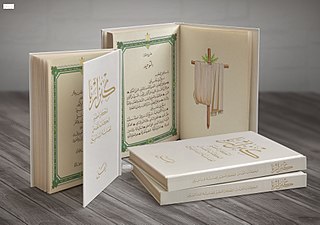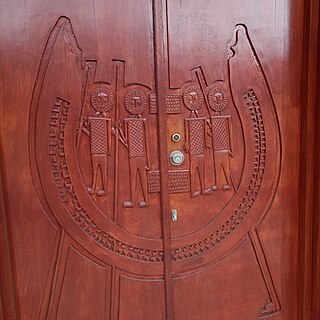
Mandaeism, sometimes also known as Nasoraeanism or Sabianism, is a Gnostic, monotheistic and ethnic religion with Greek, Iranian, and Jewish influences. Its adherents, the Mandaeans, revere Adam, Abel, Seth, Enos, Noah, Shem, Aram, and especially John the Baptist. Mandaeans consider Adam, Seth, Noah, Shem and John the Baptist prophets, with Adam being the founder of the religion and John being the greatest and final prophet.

Abatur is an Uthra and the second of three subservient emanations created by the Mandaean God Hayyi Rabbi in the Mandaean religion. His name translates as the “father of the Uthras”, the Mandaean name for angels or guardians. His usual epithet is the Ancient (Atiga) and he is also called the deeply hidden and guarded. He is described as being the son of the first emanation, or Yoshamin. He is also described as being the angel of Polaris.
In Mandaeism, manda is the concept of gnosis or spiritual knowledge. Mandaeans stress salvation of the soul through secret knowledge (gnosis) of its divine origin. Mandaeism "provides knowledge of whence we have come and whither we are going."
In Mandaeism, Rūha is the queen of the World of Darkness or underworld. She rules the underworld together with her son Ur, the king of the World of Darkness, and her entourage of the seven planets and twelve constellations, who are also her offspring with Ur.
In Mandaeism, Ptahil also known as Ptahil-Uthra, is the Fourth Life, the third of three emanations from the First Life, Hayyi Rabbi, after Yushamin and Abatur. Ptahil-Uthra alone does not constitute the demiurge but only fills that role since he is viewed as the creator of the material world in the Ginza Rabba, often holding an inherently malicious character.
In Mandaeism, the World of Light or Lightworld is the primeval, transcendental world from which Tibil and the World of Darkness emerged.
An uthra or ʿutra is a "divine messenger of the light" in Mandaeism. Charles G. Häberl and James F. McGrath translate it as "excellency". Jorunn Jacobsen Buckley defines them as "Lightworld beings, called 'utras ." Aldihisi (2008) compares them to the yazata of Zoroastrianism. According to E. S. Drower, "an 'uthra is an ethereal being, a spirit of light and Life."
The Right Ginza is one of the two parts of the Ginza Rabba, the longest and the most important holy scripture of Mandaeism. The other part of the Ginza Rabba is the Left Ginza.
In Mandaeism, Yushamin and also known as the 'Second Life', is the primal uthra and a subservient emanation who was created by the Mandaean God 'The Great Life', hence beginning the creation of the material world. Yushamin is the father of Abatur. Jorunn J. Buckley identifies Yushamin as "both a Lightworld utra beyond reproach and the prototype of a priest who has made mistakes in ritual."
In Mandaeism, Manda d-Hayyi or Manda ḏ-Hiia is an uthra sent by the Great Life as a messenger to John the Baptist. Manda d-Hayyi is considered to be the most important uthra, since he is the one bringing manda to Earth (Tibil).
In Mandaean cosmology, a maṭarta is a "station" or "toll house" that is located between the World of Light from Tibil (Earth). It has variously been translated as "watch-station", "toll-station", "way-station", or "purgatory". Maṭartas are guarded by various uthras and demons. Ruha, the queen of the underworld, is the ruler or guardian of one of the maṭartas.
In Mandaeism, Hibil or Hibil Ziwa is an uthra from the World of Light. Hibil is considered to be the Mandaean equivalent of Abel.
In Mandaeism, Yawar Ziwa is an uthra from the World of Light. He is the personification of light.
In Mandaeism, Simat Hayyi or Simat Hiia, the personification of life, is an uthra from the World of Light who is married to Yawar Ziwa.
The Mandaic word mana (ࡌࡀࡍࡀ) is a term that is roughly equivalent to the philosophical concept of nous. It has been variously translated as "mind", "soul", "treasure", "Garment", "Intelligence", "Heart", "Spirit", "Being"; or alternatively as "nous", "consciousness", or "vessel".
In Mandaeism, a dmuta or dmut is a spiritual counterpart or "mirror image" in the World of Light. People, spirits, and places are often considered to have both earthly and heavenly counterparts (dmuta) that can dynamically interact with each other. A few examples include:
In Mandaean cosmology, Mshunia Kushta is a part of the World of Light considered to be the dwelling place of heavenly or ideal counterparts (dmuta). It is similar to Plato's concept of the hyperuranion, which can be roughly described as a place in heaven where all ideas of real things are collected together.

In Mandaeism, a yardna or yardena is a body of flowing fresh water that is suitable for ritual use as baptismal water. The masbuta and other Mandaean rituals such as the tamasha can only be performed in a yardna. Stagnant fresh water, brackish water, and seawater are not considered to be yardnas.

In Mandaeism, Shahrat is a ship or boat mentioned in the Scroll of Abatur. Shahrat ferries souls from Tibil across the river Hitpun and into the house of Abatur. According to the Mandaean priest Brikha Nasoraia (2021), it is basically a "space-ship" traveling "faster than the speed of light" through ayar (ether) to higher realms.
The following outline is provided as an overview of and topical guide to Mandaeism.





